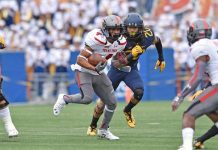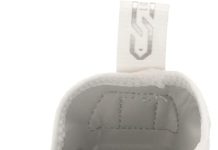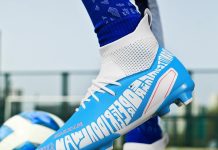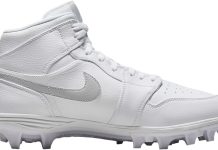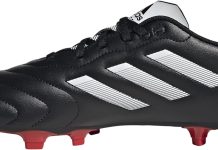Lace them up, folks, because in this article, we’re going to uncover a fascinating connection between two world-renowned sports: football and soccer. Have you ever wondered why NFL players, masters of the gridiron, would choose to don soccer cleats instead of their conventional football footwear? It’s a question that has piqued our curiosity, and today, we’re ready to unravel the mystery behind NFL players donning those shinier, sleeker kicks on the field. Get ready to discover the unexpected bond between these two beloved sports and why the inclusion of soccer cleats has made its mark in the world of American football.
Benefits of Wearing Soccer Cleats in NFL
Review contents
Traction on Various Field Conditions
One of the key benefits of wearing soccer cleats in the NFL is the superior traction they provide on various field conditions. The design of soccer cleats is optimized for gripping the ground, allowing players to have better control over their movements. Whether it’s a wet field, muddy conditions, or even artificial turf, soccer cleats offer excellent traction that helps players maintain stability and prevent slipping.
Maneuverability and Quick Directional Changes
Another advantage of soccer cleats is their design that allows for quick directional changes and enhanced maneuverability. The low-profile design of soccer cleats makes it easier for players to pivot and change directions rapidly, giving them a competitive edge on the field. This is especially important for positions that require agility and quick footwork, such as wide receivers or defensive backs.
Lightweight Design for Speed
Speed is an essential element in football, and soccer cleats are known for their lightweight design, which promotes speed and agility. With their sleek and minimalistic construction, soccer cleats offer less weight and bulk compared to traditional football cleats. This allows players to move swiftly and effortlessly, enabling them to reach their maximum speed and outperform their opponents.
Enhanced Stability and Balance
Soccer cleats are designed to provide enhanced stability and balance to athletes, which can be highly advantageous in an NFL game. The cleat’s stud pattern and placement help distribute the player’s weight evenly, reducing the risk of ankle rolls and other potential injuries. Stability and balance are critical for all players, from quarterbacks who need a firm footing in the pocket to linemen who engage in high-intensity battles in the trenches.
Compatibility with Turf Surfaces
Many NFL stadiums feature artificial turf surfaces, and soccer cleats are well-suited for these conditions. The small rubber studs on soccer cleats provide excellent traction on turf surfaces, offering optimal grip and preventing unnecessary slips or falls. This compatibility makes soccer cleats a popular choice among NFL players, ensuring they can perform at their best regardless of the playing surface.
Optimal Stud Patterns for Acceleration
Acceleration is crucial in football, and soccer cleats are specifically designed to optimize this aspect of the game. The stud patterns on soccer cleats are strategically placed to provide maximum acceleration and quick bursts of speed. These patterns enable players to push off the ground forcefully and generate explosive power, making them a valuable asset for running backs, wide receivers, and kick returners.
Flexibility and Natural Foot Movement
The flexibility of soccer cleats is another factor that appeals to NFL players. The materials used in the construction of soccer cleats allow for natural foot movement, providing a more comfortable and responsive feeling on the field. The flexible upper part of the cleats accommodates the foot’s motion, allowing players to execute agile movements and maintain the fluidity of their game.
Comfort and Fit
In any sport, comfort plays a significant role in performance, and soccer cleats excel in this aspect. The snug and ergonomic fit of soccer cleats ensures optimal comfort for players throughout the game. The design often includes cushioning and padding in key areas to reduce friction and prevent blisters or discomfort. The feel-good factor of soccer cleats combines with their technical advantages, making them a preferred choice for NFL players.
Versatility and Multi-Sport Use
Soccer cleats are not limited to just soccer; they can be used in various sports, including football. This versatility makes soccer cleats a practical choice for athletes who participate in different sports or prefer cross-training. As long as the playing surface is compatible with the cleats, they can be easily adapted for use in different sports, providing athletes with functional footwear for their diverse athletic pursuits.
Aesthetics and Personal Preference
Lastly, the aesthetics and personal preference factor cannot be overlooked when it comes to choosing soccer cleats in the NFL. Many players are drawn to the sleek and stylish designs found in soccer cleats, as they allow individuals to express their personality on the field. Different color options, patterns, and customizable features give players the freedom to wear cleats that align with their personal style while still reaping the technical benefits they offer.
Soccer Cleats vs. Football Cleats
Design and Construction
While both soccer cleats and football cleats serve the same basic purpose of providing traction and support, there are some distinct differences in their design and construction. Soccer cleats are typically made with a softer, more flexible upper material such as synthetic leather or knit fabric. This allows for greater agility and natural foot movement. Football cleats, on the other hand, may have a sturdier construction with a reinforced toe box and more rigid materials to withstand the impact and physical demands of the sport.
Spike Length and Shape
The spike length and shape differ between soccer cleats and football cleats. Soccer cleats usually have shorter and more numerous studs or spikes. These studs are designed to penetrate the ground surface slightly and offer stability and traction without impeding foot movement. Football cleats, on the contrary, often have longer and fewer spikes. The length and shape of the studs are optimized for providing traction on grass surfaces and preventing slippage during quick changes in direction.
Stud Configuration
The stud configuration is another aspect that sets soccer cleats apart from football cleats. Soccer cleats commonly feature a mix of blade-shaped and conical studs. This hybrid configuration allows for multidirectional movement, ensuring that players can move swiftly and change direction with ease. Football cleats, on the other hand, tend to have traditional conical or triangular-shaped studs that provide stability and traction on grass or turf fields.
Differentiating Factors
Apart from the technical differences in design, soccer cleats and football cleats have certain unique features that cater to the specific needs of each sport. Soccer cleats often have a thin and low-profile design to enhance player speed and ball control. In contrast, football cleats may have additional ankle support, thicker cushioning, and reinforced areas to withstand the physical contact and impact that occurs during play.
Utilization in Other Sports
While soccer cleats are primarily designed for soccer, they have gained popularity in other sports due to their technical advantages. As mentioned earlier, football players have started utilizing soccer cleats for the benefits they offer, such as improved traction and agility. Additionally, soccer cleats can be used in sports like lacrosse, rugby, and field hockey, where similar movements and field conditions are present.
Safety Considerations
It is crucial to consider safety when choosing between soccer cleats and football cleats. The physical demands and the potential for collisions in football necessitate cleats that provide stability, ankle support, and impact protection. Football cleats are designed with these factors in mind, aiming to minimize the risk of injuries. However, if a player prefers soccer cleats in the NFL, it is essential to ensure that the cleats meet the safety requirements set by the league and provide adequate protection for the specific position and playing style.
Impact on Performance and Injury Prevention
Traction and Acceleration
The traction and acceleration provided by soccer cleats have a direct impact on a player’s performance. The superior grip offered by the cleat’s stud patterns enables quick acceleration from a stationary position or during sprints, giving players an edge on the field. The ability to generate explosive power and maintain stability while changing direction can significantly enhance a player’s overall performance.
Agility and Footwork
Agility and precise footwork are essential skills in football, especially for positions such as wide receivers, running backs, and defensive backs. Soccer cleats’ lightweight design and optimal stud patterns facilitate swift movements and quick changes in direction, allowing players to navigate the field with agility and finesse. The enhanced maneuverability and responsiveness of soccer cleats play a crucial role in the execution of agile moves and evasive maneuvers.
Planting and Cutting
In football, the ability to plant and cut effectively is crucial for both offensive and defensive players. Soccer cleats provide the necessary traction and stability for players to plant their feet firmly in the ground and execute sharp cuts or change direction explosively. The ability to maintain balance and control during these movements can be attributed to the design of soccer cleats, which optimize foot-to-surface contact and reduce slippage.
Joint Stability
Joint stability is a crucial aspect of injury prevention in football. Soccer cleats contribute to joint stability by offering a secure and snug fit that helps stabilize the ankles and feet. The cleat’s construction and stud patterns aid in distributing the athlete’s weight evenly, reducing the risk of hyperextension or lateral ankle sprains. This stability greatly benefits players in positions that require sudden stops, pivots, and high-impact movements.
Ankle Support
While soccer cleats may not provide as much ankle support as specialized football cleats, they can still offer significant stability to the ankle joint. The snug fit of soccer cleats and the construction of the upper material can provide a degree of support and help prevent excessive ankle rolls. However, players who require additional ankle support should consider specialized football cleats designed with reinforced ankle collars and extra padding.
Foot and Toe Protection
Football involves high-intensity physical contact, and foot and toe protection is essential for player safety. Soccer cleats often feature reinforced toe boxes and cushioning to absorb impacts and minimize the risk of toe injuries. The lightweight and flexible design of soccer cleats ensure that players can move with agility while still benefiting from necessary foot protection.
Minimizing Slippage and Falls
Slippage and falls can be detrimental to a player’s performance and increase the risk of injuries. Soccer cleats’ specialized stud patterns and traction abilities minimize slippage, allowing players to maintain their footing even in adverse weather conditions or on slippery surfaces. The secure traction offered by soccer cleats contributes to overall stability, reducing the likelihood of falls and maintaining a solid foundation during play.
Bone and Ligament Injuries
Bone fractures and ligament injuries are common in high-impact sports like football. While soccer cleats can help prevent certain injuries through their design features, such as stability and traction, they cannot eliminate the risk entirely. It remains crucial for players to wear appropriate protective equipment and follow proper technique to minimize the potential for severe injuries.
Consistency in Footwear
Maintaining consistency in footwear is essential for players to optimize their performance and reduce the risk of injuries. By sticking to soccer cleats throughout their athletic career, NFL players can develop familiarity and confidence with their chosen footwear. Consistency in footwear choice allows players to focus on their game without having to adjust to different cleats, ensuring they can perform at their best without distractions.
Influence of Player Position and Playing Style
Offensive Positions
The influence of soccer cleats on a player’s performance can vary depending on their position and playing style. Offensive positions, such as quarterbacks and wide receivers, often benefit from the lightweight design and agility-enhancing features of soccer cleats. These positions require quick movements, precise footwork, and the ability to change direction rapidly, making soccer cleats a favorable choice.
Defensive Positions
Defensive positions, particularly those involved in pass rushing or covering wide receivers, can also benefit from soccer cleats. The lightweight design and traction offered by soccer cleats enable defensive players to react quickly to offensive plays, allowing them to stay with their opponents and make agile movements to reach the ball or tackle opposing players. The flexibility and maneuverability provided by soccer cleats can be advantageous for cornerbacks, safeties, and linebackers.
Special Team Positions
Special team positions, such as kickers, punters, and return specialists, often have specific footwear preferences. While kickers and punters may opt for specialized kicking shoes, return specialists can benefit from soccer cleats due to their agility and traction advantages. The ability to quickly change directions and accelerate can give return specialists an extra edge in evading tackles and finding open lanes.
Aggressive vs. Conservative Playing Style
A player’s playing style can also influence their choice of cleats. Aggressive players who rely on explosive speed and quick movements may gravitate towards soccer cleats for their enhanced traction and maneuverability. On the other hand, players with a more conservative playing style may prefer football cleats that provide additional ankle support and stability. Ultimately, the choice of cleats should align with the individual player’s style and preferences.
Player’s Preference and Comfort
Player preference and comfort play a vital role in the selection of footwear. Every player has unique preferences when it comes to the feel, fit, and performance of their cleats. Some players may find soccer cleats more comfortable due to their lightweight and flexible design. The ability to customize soccer cleats to suit personal preferences in terms of aesthetics and fit adds to their appeal. The comfort and satisfaction derived from wearing soccer cleats can have a positive impact on a player’s confidence and overall performance on the field.





